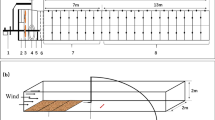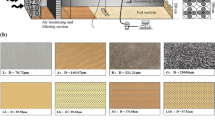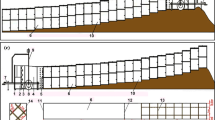Abstract
Key message
Wing loading, diaspore type (round-winged vs. single-winged), and aerodynamic motion (autogyro vs. floater) influence the terminal velocity of wind-dispersed diaspores and falling patterns.
Abstract
The dispersal ability of diaspores dispersed by wind can be reflected in the terminal velocity of the diaspore. Therefore, we measured the terminal velocity of wind-dispersed diaspores in 17 major forest and urban tree species in South Korea and tracked falling diaspore patterns up to the achievement of terminal velocity using the video camera recording method. In addition, the morphological characteristics of the diaspores were measured, and their effect on diaspore terminal velocity tested. Chamaecyparis obtusa (2.66 m s−1) had the highest terminal velocity, whereas Picea abies (0.61 m s−1) had the lowest terminal velocity. Falling diaspores achieved terminal velocity through (1) the oscillating falling pattern of floater diaspores, with a constant descent velocity with minor increases and decreases; (2) the decelerating falling pattern of single-winged diaspores, with accelerating descent velocity followed by rapid deceleration to terminal velocity; or (3) the accelerating falling pattern of round-winged autogyro diaspores, with descent velocity increasing steadily up to terminal velocity. The terminal velocities of single-winged diaspores were significantly lower than those of round-winged diaspores. Although there were cases of similar terminal velocity between species in the same genera (e.g., Abies, Pinus), there were large intraspecific differences in terminal velocity within the same genus due to morphological differences (e.g., Acer). The measured terminal velocities could be applied in simulations for diaspore dispersal distances for forestry tree species. The present study explored the relationship between diaspore morphological characteristics and terminal velocity, and is the first to report the dispersal ability of wind-dispersed seeds of major tree species in East Asia. The findings of the present study can be adopted as key input variables in seed dispersal modeling and facilitate the establishment of natural regeneration plans and conservation of endangered species in the wake of climate change.





Similar content being viewed by others
Data Availability
The datasets generated and/or analyzed during the current study are available from the corresponding author upon reasonable request.
References
Ashton MS, Kelty MJ (2018) The Practice of Silviculture. 10th ed. Ecology of regeneration, 5th edn. Wiley, New York, pp 80–116
Askew AP, Corker D, Hodkinson DJ, Thompson K (1997) A new apparatus to measure the rate of fall of seeds. Funct Ecol 11:121–125. https://doi.org/10.1046/j.1365-2435.1997.00049.x
Augspurger CK (1986) Morphology and dispersal potential of wind-dispersed diaspores of neotropical trees. Am J Bot 73:353–363
Benkman CW (1995) Wind dispersal capacity of pine seeds and the evolution of different seed dispersal modes in pines. Oikos 73:221–224
Cain ML, Milligan BG, Strand AE (2000) Long-distance seed dispersal in plant populations. Am J Bot 87:1217–1227. https://doi.org/10.2307/2656714
Choi S, Lee WK, Kwak DA, Lee S, Son Y, Lim JH, Saborowski J (2011) Predicting forest cover changes in future climate using hydrological and thermal indices in South Korea. Clim Res 49:229–245. https://doi.org/10.3354/cr01026
Debain S, Curt T, Lepart J (2003) Seed mass, seed dispersal capacity, and seedling performance in a Pinus sylvestris population. Ecoscience 10:168–175. https://doi.org/10.1080/11956860.2003.11682764
FFmpeg Developers (2021) ffmpeg tool (Version be1d324) [Software]. http://ffmpeg.org/
Fricke EC, Tewksbury JJ, Rogers HS (2019) Linking intra-specific trait variation and plant function: seed size mediates performance tradeoffs within species. Oikos 128:1716–1725. https://doi.org/10.1111/oik.06494
Gao J, Liao PC, Huang BH, Yu T, Zhang YY, Li JQ (2020) Historical biogeography of Acer L. (Sapindaceae): genetic evidence for Out-of-Asia hypothesis with multiple dispersals to North America and Europe. Sci Rep 10:1–10. https://doi.org/10.1038/s41598-020-78145-0
Gärtner SM, Lieffers VJ, Macdonald SE (2011) Ecology and management of natural regeneration of white spruce in the boreal forest. Environ Rev 19:461–478. https://doi.org/10.1139/a11-017
Ghimire B, Yeom D, Jeong MJ (2019) Seed Atlas of Korea I. Conifers J Asia Pac Biodivers 12:459–466. https://doi.org/10.1016/j.japb.2019.03.011
Gómez-Noguez F, León-Rossano LM, Mehltreter K, Orozco-Segovia A, Rosas-Pérez I, Pérez-García B (2017) Experimental measurements of terminal velocity of fern spores. Am Fern J 107:59–71. https://doi.org/10.1640/0002-8444-107.2.59
Green DS (1980) The terminal velocity and dispersal of spinning samaras. Am J Bot 67:1218–1224. https://doi.org/10.1002/j.1537-2197.1980.tb07754.x
Greene DF, Johnson EA (1989) A model of wind dispersal of winged or plumed seeds. Ecology 70:339–347. https://doi.org/10.2307/1937538
Greene DF, Johnson EA (1993) Seed mass and dispersal capacity in wind-dispersed diaspores. Oikos 67:69–74
Greene DF, Johnson EA (1995) Long-distance wind dispersal of tree seeds. Canad J Bot 73:1036–1045. https://doi.org/10.1139/b95-113
Groom PK (2010) Implications of terminal velocity and wing loading on Hakea (Proteaceae) seed dispersal. J R Soc West Aust 93:175
Hiura T, Go S, Iijima H (2019) Long-term forest dynamics in response to climate change in northern mixed forests in Japan: a 38-year individual-based approach. For Ecol Manag 449:117469. https://doi.org/10.1016/j.foreco.2019.117469
Jongejans E, Schippers P (1999) Modeling seed dispersal by wind in herbaceous species. Oikos 87:362–372
Kelly AE, Goulden ML (2008) Rapid shifts in plant distribution with recent climate change. Proc Natl Acad Sci USA 105:11823–11826. https://doi.org/10.1073/pnas.0802891105
Kim M, Lee S, Lee S, Yi K, Kim HS, Chung S, Chung J, Kim HS, Yoon TK (2022) Seed dispersal models for natural regeneration: a review and prospects. Forests 13:659. https://doi.org/10.3390/f13050659
Koo KA, Kong WS, Park SU, Lee JH, Kim J, Jung H (2017) Sensitivity of Korean fir (Abies koreana Wils.), a threatened climate relict species, to increasing temperature at an island subalpine area. Ecol Modell 353:5–16. https://doi.org/10.1016/j.ecolmodel.2017.01.018
Kruse S, Gerdes A, Kath NJ, Herzschuh U (2018) Implementing spatially explicit wind-driven seed and pollen dispersal in the individual-based larch simulation model: LAVESI-WIND 1.0. Geosci Model Dev 11:4451–4467. https://doi.org/10.5194/gmd-11-4451-2018
Kuparinen A (2006) Mechanistic models for wind dispersal. Trends Plant Sci 11:296–301. https://doi.org/10.1016/j.tplants.2006.04.006
Landenberger RE, Kota NL, McGraw JB (2007) Seed dispersal of the non-native invasive tree Ailanthus altissima into contrasting environments. Plant Ecol 192:55–70. https://doi.org/10.1007/s11258-006-9226-0
Landhäusser SM, Pinno BD, Mock KE (2019) Tamm Review: seedling-based ecology, management, and restoration in aspen (Populus tremuloides). For Ecol Manag 432:231–245. https://doi.org/10.1016/j.foreco.2018.09.024
Lee SJ, Lee EJ, Sohn MH (2014) Mechanism of autorotation flight of maple samaras (Acer palmatum). Exp Fluids 55:1–9. https://doi.org/10.1007/s00348-014-1718-4
Lentink D, Dickson WB, Van Leeuwen JL, Dickinson MH (2009) Leading-edge vortices elevate lift of autorotating plant seeds. Science 324:1438–1440. https://doi.org/10.1126/science.1174196
Liang W, Liu Z, Liu M, Qin X, Baskin CC, Baskin JM, Xin Z, Wang Z, Su Z, Zhou Q (2020) Wing loading, not terminal velocity, is the best parameter to predict capacity of diaspores for secondary wind dispersal. J Exp Bot 71:4298–4307. https://doi.org/10.1093/jxb/eraa170
Liu M, Xin Z, Su Z, Zhao Y, Li X, Liu Z, Cony MA, Liang W, Qin X, Qian J, Cui X, Zhou Q (2021) A video camera recording method for measuring terminal velocity of seed dispersal by wind. J for Res (harbin) 32:81–90. https://doi.org/10.1007/s11676-019-01092-8
Matlack GR (1987) Diaspore size, shape, and fall behavior in wind-dispersed plant species. Am J Bot 74:1150–1160. https://doi.org/10.1002/j.1537-2197.1987.tb08729.x
McCutchen CW (1977) The spinning rotation of ash and tulip tree samaras. Science 197:691–692. https://doi.org/10.1126/science.197.4304.691
Michaels HJ, Benner B, Hartgerink AP, Lee TD, Rice S, Willson MF, Bertin RI (1988) Seed size variation: magnitude, distribution, and ecological correlates. Evol Ecol 2:157–166. https://doi.org/10.1007/BF02067274
Minami S, Azuma A (2003) Various flying modes of wind-dispersal seeds. J Theor Biol 225:1–14. https://doi.org/10.1016/S0022-5193(03)00216-9
Nathan R, Safriel UN, Noy-Meir I (2001) Field validation and sensitivity analysis of a mechanistic model for tree seed dispersal by wind. J Ecol 82:374–388. https://doi.org/10.1890/0012-9658(2001)082[0374:FVASAO]2.0.CO;2
Nathan R, Katul GG, Bohrer G, Kuparinen A, Soons MB, Thompson SE, Trakhtenbrot A, Horn HS (2011) Mechanistic models of seed dispersal by wind. Theor Ecol 4:113–132. https://doi.org/10.1007/s12080-011-0115-3
Neilson RP, Pitelka LF, Solomon AM, Nathan RAN, Midgley GF, Fragoso JM, Lischke H, Thompson KEN (2005) Forecasting regional to global plant migration in response to climate change. Bioscience 55:749–759. https://doi.org/10.1641/0006-3568(2005)055[0749:FRTGPM]2.0.CO;2
Pazos GE, Greene DF, Katul G, Bertiller MB, Soons MB (2013) Seed dispersal by wind: towards a conceptual framework of seed abscission and its contribution to long-distance dispersal. J Ecol 101:889–904. https://doi.org/10.1111/1365-2745.12103
Qin X, Liang W, Liu Z, Liu M, Baskin CC, Baskin JM, Baskin JM, Xin Z, Wang Z, Zhou Q (2022) Plant canopy may promote seed dispersal by wind. Sci Rep 12:1–9. https://doi.org/10.1038/s41598-021-03402-9
R Core Team (2020) R: A language and environment for statistical computing. R Foundation for Statistical Computing, Vienna, Austria
Schneider CA, Rasband WS, Eliceiri KW (2012) NIH Image to ImageJ: 25 years of image analysis. Nat Methods 9:671–675. https://doi.org/10.1038/nmeth.2089
Schupp EW, Jordano P, Gómez JM (2010) Seed dispersal effectiveness revisited: a conceptual review. New Phytol 188:333–353. https://doi.org/10.1111/j.1469-8137.2010.03402.x
Seale M, Nakayama N (2020) From passive to informed: mechanical mechanisms of seed dispersal. New Phytol 225:653–658. https://doi.org/10.1111/nph.16110
Sykes MT (2009) Climate change impacts: vegetation. Els. https://doi.org/10.1002/9780470015902.a0021227
Tan K, Dong SP, Lu T, Zhang YJ, Xu ST, Ren MX (2018) Diversity and evolution of samara in angiosperm. Chin J Plant Ecol 42:806. https://doi.org/10.17521/cjpe.2018.0053
Walck JL, Hidayati SN, Dixon KW, Thompson KEN, Poschlod P (2011) Climate change and plant regeneration from seed. Glob Change Biol 17:2145–2161. https://doi.org/10.1111/j.1365-2486.2010.02368.x
Wyse SV, Hulme PE, Holland EP (2019) Partitioning intraspecific variation in seed dispersal potential using a low-cost method for rapid estimation of samara terminal velocity. Methods Ecol Evol 10:1298–1307. https://doi.org/10.1111/2041-210X.13202
Zakaria MY, Dos Santos CR, Dayhoum A, Marques F, Hajj MR (2019) Modeling and prediction of aerodynamic characteristics of free fall rotating wing based on experiments. ASAT 18:1–15. https://doi.org/10.1088/1757-899X/610/1/012098
Zhou W (1998) Optimal natural regeneration of Scots pine with seed trees. J Environ Manag 53:263–271. https://doi.org/10.1006/jema.1998.0210
Zhu J, Liu M, Xin Z, Liu Z, Schurr FM (2019) A trade-off between primary and secondary seed dispersal by wind. Plant Ecol 220:541–552. https://doi.org/10.1007/s11258-019-00934-z
Acknowledgements
This research was supported by a research fund of the Forest Technology and Management Research Center, National Institute of Forest Science (SC0400-2021-01-2022), and Sangji University Graduate School.
Funding
This research was supported by a research fund of the Forest Technology and Management Research Center, National Institute of Forest Science (SC0400-2021-01-2021).
Author information
Authors and Affiliations
Contributions
All the authors contributed to the conception and design of the study. Material preparation was done by HK, SC, and JC. SL, TKY, and SL collected and analyzed the data. The first draft of the manuscript was written by SL and TKY, and the other authors commented on previous versions of the manuscript. All authors have read and approved the final manuscript.
Corresponding author
Ethics declarations
Competing interests
The authors have no relevant financial or non-financial interests to disclose.
Additional information
Communicated by Speck.
Publisher's Note
Springer Nature remains neutral with regard to jurisdictional claims in published maps and institutional affiliations.
Supplementary Information
Below is the link to the electronic supplementary material.
Rights and permissions
About this article
Cite this article
Lee, S., Lee, S., Kim, H.S. et al. Terminal velocities and falling patterns correlate with morphology of diaspores in wind-dispersed forestry species. Trees 36, 1865–1879 (2022). https://doi.org/10.1007/s00468-022-02334-9
Received:
Accepted:
Published:
Issue Date:
DOI: https://doi.org/10.1007/s00468-022-02334-9




